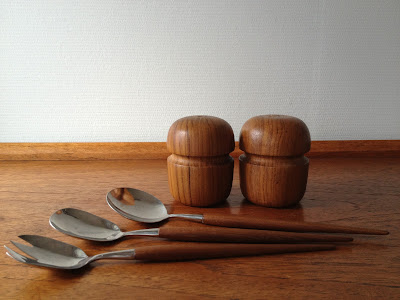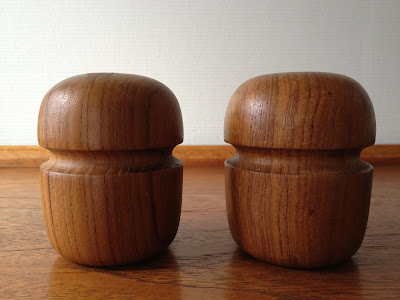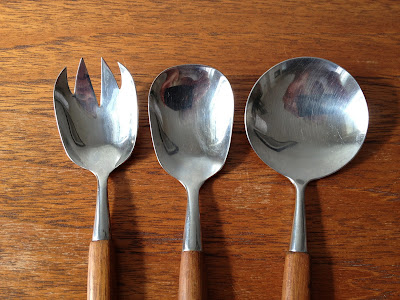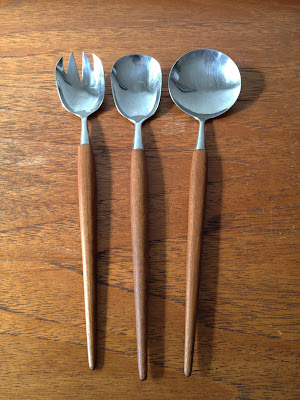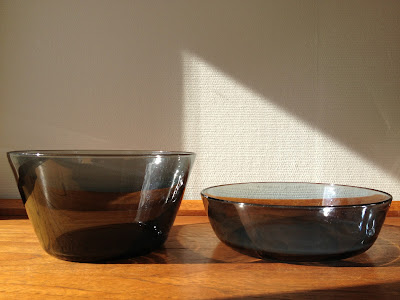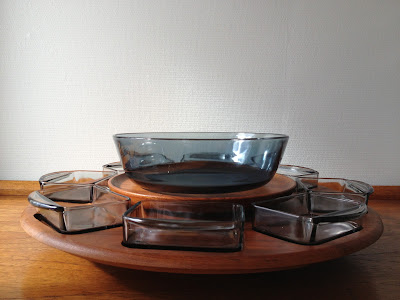I have a thing for icy cool finnish glass, and this week has been very rewarding in that respect. I found some gorgeous Ultima Thule glasses, featured in my previous post, and now these! Remember I mentioned in a recent post that the lady in my nearby thriftstore had reserved something for me that just needed to be unpacked from all her boxes? That was four Festivo candle holders in two different sizes. Or at least I thought it was... When I popped by a few days ago, she was really sorry about having discovered they were copies. I was so disappointed, but bless her for not trying to convince me they were originals. However, yesterday, I found two specimen of the genuine article- they're even signed! Sadly there are many copies around. Over here, I often see the kind that are too regular and don't have that special icy expression at all. The real ones have a rougher surface and look more "individual". If you're lucky, like I was this time, you'll find the older ones that have Sarpaneva's initials TS etched under the base. I highly recommend you to check out this post over at RetroScandinavian if you wanna make sure you're getting the real deal. It's a really great blog, by the way, a great resource on Scandinavian pottery and glass.
I want to collect a whole group in different heights, like in this great retro Iittala ad I found. It must date from the early years, maybe even from the time they were launched. The retro typeface is so cool. Aren't they gorgeous in a large group like that? The tall ones are hard to find, we'll see how that goes... My mom has a pair with one ring that my dad bought for her on a business trip to Helsinki in the early 70s. She confessed to me a little while ago that she's never liked them, and wants me to have them. She wants to break it to my dad gently, though, she never told him she didn't like them... For the record; my dad doesn't read my blog!
I want to collect a whole group in different heights, like in this great retro Iittala ad I found. It must date from the early years, maybe even from the time they were launched. The retro typeface is so cool. Aren't they gorgeous in a large group like that? The tall ones are hard to find, we'll see how that goes... My mom has a pair with one ring that my dad bought for her on a business trip to Helsinki in the early 70s. She confessed to me a little while ago that she's never liked them, and wants me to have them. She wants to break it to my dad gently, though, she never told him she didn't like them... For the record; my dad doesn't read my blog!
I guess many of you are well acquainted with Festivo and the amazing Timo Sarpaneva, but if you're not- let me introduce you! The story goes that designer Timo Sarpaneva originally designed the Festivo candle holder as a wine glass for himself. The idea was to fit an entire bottle of wine into a single glass. A rough-surfaced, ice-like glass was born, with the bowl and base sections blown separately. When the base sections of the glasses were sitting in the factory on their own, the idea came to use them as candle holders – and so the prototype of a new classic was born. The Festivo series has been manufactured since 1967 and has become a true icon.
Timo Sarpaneva came from a family of craftsmen. He would mention his maternal grandfather, a blacksmith, whose profession Sarpaneva claimed as his family's tradition "for hundreds of years," and said others were textile artists noting his mother used to make tea cozies. His one-year-older brother Pentti was a graphic designer and made the most amazing brutalist bronze and silver jewelry.
Timo Sarpaneva's professional response to glass was related to his early memories of molten metal in his grandfather's workshop. A childhood sensation that he would periodically recount later as inspirational for his innovative approach to glass objects spoke of transparency and space:
Timo Sarpaneva's professional response to glass was related to his early memories of molten metal in his grandfather's workshop. A childhood sensation that he would periodically recount later as inspirational for his innovative approach to glass objects spoke of transparency and space:
"At the age of eight or nine, I held a piece of ice in my hand until I'd made a hole in it with my warm finger."
His organic hole in a glass body then appeared at roughly the same time as Henry Moore began to make use of concavities in his human sculptures, and some of his other work with glass is suggestive of that experience.
Sarpaneva graduated from the Institute for Industrial Arts (the forerunner of the University of Arts and Design in Helsinki in 1948 and received a PhD later. Shortly after he began to work with glass. He was hired by Iittala in 1951. Radical for that time, his involvement extended to the design of the packaging and of Iittala's name with a prominent, white, lower-case letter i in a red circle as the new line's trademark, which the company then adopted as its universal logo through the 21st century.
Sarpaneva's first international recognition in glass work came with a Grand Prix from the Milan Triennale in 1954 that included Sarpaneva's series Orkidea ("Orchid"), Kajakki ("Kayak"), and Lansetti ("Lancet") adopted for production by Iittala.
Sarpaneva's first international recognition in glass work came with a Grand Prix from the Milan Triennale in 1954 that included Sarpaneva's series Orkidea ("Orchid"), Kajakki ("Kayak"), and Lansetti ("Lancet") adopted for production by Iittala.
Trained as a graphic designer, he spent the majority of his life in industrial design while seeing himself more as an artist than a designer. During his amazing career, he created great designs in glass, porcelain, fabric and cast iron, to name a few. However, glass was always closest to his heart. He said of his favorite material:
"Glass is very mysterious. It's changing all the time. That's what makes it magical. It released me from the conventional and the three-dimensional. It opened its deepest reaches to me and took me on a journey to a fourth dimension. I understood the opportunities that clear, transparent glass gives to an artist and designer."







